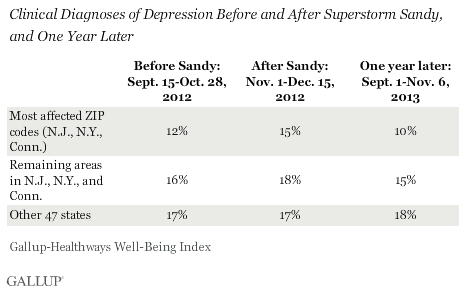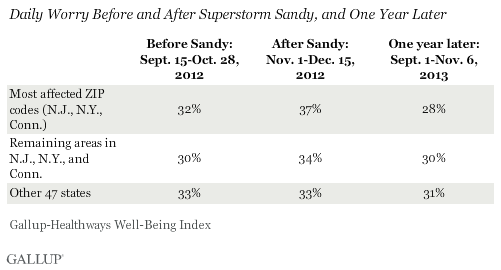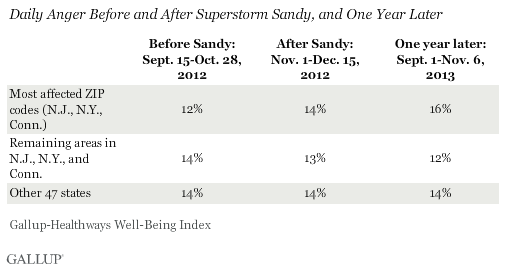WASHINGTON, D.C. -- While residents of the affected areas may never forget the devastation of Superstorm Sandy, they appear to be recovering emotionally. One year after Superstorm Sandy swept through New Jersey, New York, and Connecticut, reports of clinical depression among those in the hardest hit areas have mostly returned to levels seen before the storm.

Gallup found that there was a 25% increase in depression diagnoses among residents of ZIP codes most affected by Superstorm Sandy immediately following the storm, but the depression rate is now lower than it was before the storm. Similarly, those living elsewhere in New Jersey, New York, and Connecticut also report lower levels of depression that match levels seen before the storm. In contrast, the rest of the United States did not experience any significant changes in depression over this period of time.
Gallup asks respondents if a physician or nurse has ever diagnosed them with depression at any point. Therefore, these findings do not necessarily imply that the storm itself led to new depression cases or that recovery operations helped those suffering from the illness. Still, the significant increase in diagnoses of clinical depression shortly after the storm reveals that depression had climbed considerably in the areas most affected by Sandy at a time when there was no change throughout the remainder of the country.
Subsequent reductions in lifetime depression reports in 2013 could suggest population or demographic shifts over the period, potentially including some of those who reported depression incidences may no longer reside in the area or more people who have never been diagnosed moved into the area. Additionally, certain demographic groups may have experienced increases in diagnoses, while larger groups could have had fewer cases, thereby netting lower numbers across the region.
Worry Also Recovers in Sandy-Affected Areas; Anger Worsens
Residents living in the ZIP codes most impacted by Sandy -- as well as those living elsewhere in New Jersey, New York, and Connecticut -- also reported a significant increase in worry on any given day after the storm, while there was no change in worry among the rest of the U.S. As with depression, reports of feeling worry "a lot of the day yesterday" now match or have fallen below levels seen before the storm throughout these three states, and the level of worry for residents in the worst hit areas is now below the level found in the nation's 47 remaining states.

Anger, in contrast, has slightly increased among those living in the ZIP codes most affected by the storm, but has not changed elsewhere. While this increase is significant, it is unclear whether the slow recovery from the storm or some other factor may be causing the uptick. The media is still reporting that many residents still need assistance and resources, which may be contributing to the increase in anger.

The most recent findings are based on daily interviews conducted as part of the Gallup-Healthways Well-Being Index from Sept. 1-Nov. 6, 2013.
Gallup included a total of 9,409 interviews with residents of New Jersey, New York, and Connecticut and divided these responses into two geographies -- ZIP codes hardest hit by Sandy -- those receiving Individual Assistance from the Federal Emergency Management Agency -- and the remaining ZIP codes in those three states.
During the same periods, Gallup also conducted 71,265 interviews in the remaining 47 states in 2012 and 30,701 interviews in 2013.
Implications
In the wake of Typhoon Haiyan's catastrophic destruction in the Philippines, many leaders are going to spend significant time and resources identifying, understanding, and addressing the immediate impact of the disaster. However, measuring the long-term outcomes of recovery will also be difficult and complex.
As FEMA indicates in their National Disaster Recovery Framework, recovery means much more than removing debris and ensuring housing for those displaced. The emotional toll of the event on a massive scale can be difficult to address, and changing emotional responses are likely to persist beyond the immediate aftermath.
Disasters and the populations they affect are unique, so it is challenging to make wide-ranging policies to address the emotional impact. For example, in previous Gallup research regarding the BP Deep Water Horizon oil spill, emotional well-being across the most impacted regions had not recovered even after two years, although the local economy was improving. Given the extent and severity of the damage from Typhoon Haiyan, the emotional resilience of residents in the Philippines will certainly be tested.
Disasters and emergencies surely leave lasting impressions on those affected, but understanding that these emotions may not be just temporary reactions can help inform leaders and individuals on how to recover in the long term.
About the Gallup-Healthways Well-Being Index
The Gallup-Healthways Well-Being Index tracks U.S. well-being and provides best-in-class solutions for a healthier world. To learn more, please visit well-beingindex.com.
Survey Methods
The original 2012 results are based on 6,414 interviews conducted from Sept. 15-Dec. 15 with adult residents of New Jersey, New York, and Connecticut. Of these interviews, 1,713 occurred before the storm (Sept. 15-Oct. 28) and another 1,690 after the storm (Oct. 31-Dec. 15) in areas most impacted by Sandy, with another 1,433 before the storm and 1,578 after the storm among remaining residents of the three states. During the same period, 35,184 interviews were completed before the storm and 36,081 after it among residents of the remaining 47 states.
Results for one year later in 2013 are based on 2,995 interviews conducted from Sept. 1-Nov.6, with adult residents of New Jersey, New York, and Connecticut. Of these, 1,661 were conducted in the areas most impacted by Sandy, with another 1,334 with remaining residents of the three states. Another 30,701 interviews were completed adults in the 47 remaining states.
For results based on the three sample types for either before or after the storm, one can say with 95% confidence that the typical margin of sampling error is ±2.1, ±2.4, and ±0.5 percentage points, respectively, for each emotional health metric.
Interviews are conducted with respondents on landline telephones (for respondents with a landline telephone) and cellular phones (for respondents who are cellphone only).
In addition to sampling error, question wording and practical difficulties in conducting surveys can introduce error or bias into the findings of public opinion polls.
For more details on Gallup's polling methodology, visit www.gallup.com.
